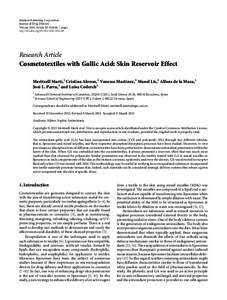Cosmetotextiles with gallic acid: skin reservoir effect

Visualitza/Obre
Cita com:
hdl:2117/26785
Tipus de documentArticle
Data publicació2013-03-11
EditorHINDAWI
Condicions d'accésAccés obert
Llevat que s'hi indiqui el contrari, els
continguts d'aquesta obra estan subjectes a la llicència de Creative Commons
:
Reconeixement 3.0 Espanya
Abstract
The antioxidant gallic acid (GA) has been incorporated into cotton (CO) and polyamide (PA) through two different vehicles, that is, liposomes and mixed micelles, and their respective absorption/desorption processes have been studied. Moreover, in vitro percutaneous absorption tests of different cosmetotextiles have been performed to demonstrate antioxidant penetration within the layers of the skin. When GA was embedded into the cosmetotextiles, it always promoted a reservoir effect that was much more marked than that observed for polyamide. Similar penetration was observed in the textiles treated with GA in mixed micelles or liposomes in such compartments of the skin as the stratum corneum, epidermis, and even the dermis. GA was detected in receptor fluid only when CO was treated with MM. This methodology may be usef ul in verifying how encapsulate ed substances incorporated into textile materials penetrate human skin. Indeed, such materials can be considered strategic delivery systems that release a given active compound into the skin at specific doses
CitacióMarti, M. [et al.]. Cosmetotextiles with gallic acid: skin reservoir effect. "Journal of Drug Delivery", 11 Març 2013, vol. 2013, p. 1-7.
ISSN2090-3022
Versió de l'editorhttp://www.hindawi.com/journals/jdd/2013/456248/
| Fitxers | Descripció | Mida | Format | Visualitza |
|---|---|---|---|---|
| 456248.pdf | 844,4Kb | Visualitza/Obre |


